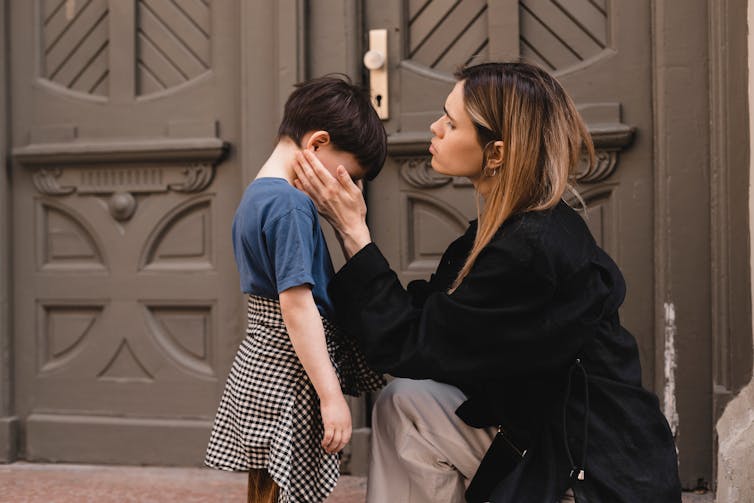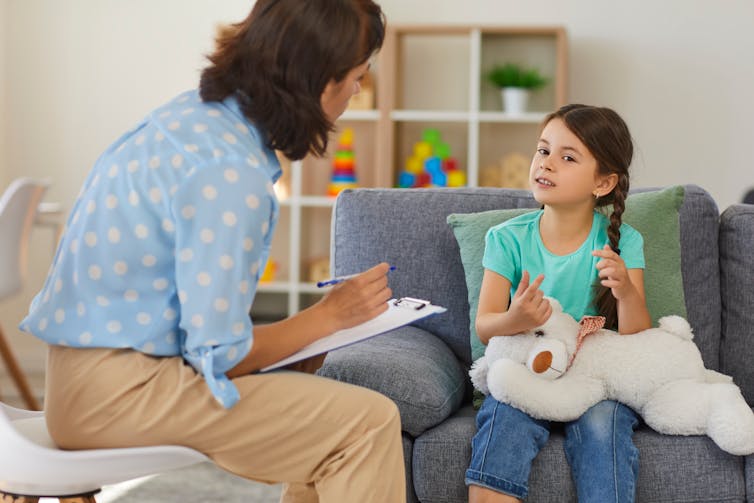
10 Dec Can EMDR help children recover from trauma?
What is eye movement desensitisation and reprocessing (EMDR)? researchers Peta Stapleton and Cher McGillivray look at the current theories.
Childhood traumatic experiences are common. Almost one in three (32%) Australians reported being physically abused as a child, 31% experienced emotional abuse, 28.5% were victims of sexual abuse and 9% were neglected. Some 40% of Australians were exposed to domestic violence against a parent.
Untreated childhood trauma is associated with an increased risk of mental health disorders. These children are more likely to become teens and adults who binge drink, attempt suicide and self-harm.
To reduce the chance of these long-term negative effects, it’s important to understand what treatments work for trauma in children. One option is eye movement desensitisation and reprocessing, or EMDR, a therapy which aims to reduce distress and traumatic memories.
So how does EMDR work? And how strong is its evidence base?
What is EMDR?
EMDR first emerged in the late 1980s and is now recognised as a suitable approach for adults and children.
In EMDR, clients are first assisted to gain insight into what is causing their distress.
In a subsequent phase of the therapy, the client holds the traumatic memory in their mind, while moving their eyes backwards and forward, tracking the therapist’s hand.
Their eye movements are complemented by a tapping technique (tapping the knees one at a time) or an auditory tone played in each ear.
The client then focuses on a preferred positive belief to replace the trauma they have processed.
How does EMDR work? The two main theories
It is suggested eye movements decrease the physical distress sensations by activating the parasympathetic nervous system, associated with a restful and calm state. Moving the eyes backwards and forward is also thought to assist with accessing earlier memories.
Another theory to explain why EMDR is effective centres on the different activities the client is doing all at once, and how this impacts working memory. By moving the eyes, holding the distressing memory front of mind, tapping on the knees and/or listening to auditory tones in each ear, it is thought the working memory is disrupted, and therefore open to being changed.

Shutterstock
How does EMDR compare with CBT for children?
The small number of studies conducted so far suggests EMDR can help children with post-traumatic stress disorder to reduce symptoms of emotional upset, depression, anxiety and behavioural issues such as sleeping.
These outcomes are similar to trauma-focused cognitive behaviour therapy.
EMDR has also been beneficial (and as effective as other therapies) for children who experienced natural disasters.
Generally, six to 12 sessions is sufficient for EMDR treatment, compared to 12 to 15 for trauma-focused cognitive behaviour therapy.
However, EMDR cannot be used with clients unless the therapist is appropriately trained and qualified.
How does EMDR compare with other ‘exposure’ therapies?
An American Psychological Association review concluded the effectiveness of EMDR for adults and children is still inconsistent.
While EMDR appears more efficient than trauma-focused cognitive behaviour therapy, with fewer sessions required, the outcomes are equivalent to other exposure therapies (which use the same process to work through trauma) without eye movements.

Shutterstock
The true mechanism of the eye movements in EMDR is still unclear. Research suggests the benefits of EMDR may come from other factors that assist with behaviour-change or reducing distress, such as the relationship between the therapist and client or the client’s motivation to change.
So overall, the research on EMDR is still mixed. Studies conducted on children with trauma and larger sample sizes are needed for more conclusive results.
What really matters in trauma therapy for kids?
If children view themselves as being responsible for the traumatic event, in order to cope they will distance themselves from ongoing trauma by disowning that bad or wounded part of themselves. This alienation of themselves helps them survive but maintains their trauma symptoms.
Shame and suppression of self can lead to behavioural outbursts or shut-down coping strategies. This leaves the child easily triggered, living in their survival brain and oscillating between their fight, flight, freeze or fawn (people-pleasing) states.
Helping children restore their sense of self, assisting them to learn to cope with big emotions is important and we can do that in safe relationships.
It’s also crucial to help parents understand the impact of their wellbeing on the their child’s recovery. Improving parents’ wellbeing and feelings of competence can help heal themselves and their children.
Physician and trauma expert Gabor Mate rightly said children don’t get traumatised because they are hurt. They get traumatised because they’re alone with the hurt.![]()
Peta Stapleton, Associate Professor in Psychology, Bond University and Cher McGillivray, Assistant Professor Psychology Department, Bond University
Main Image: Charlein Gracia/Unsplash
This article is republished from The Conversation under a Creative Commons license. Read the original article.

